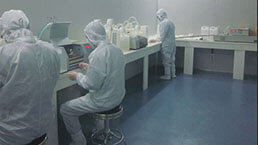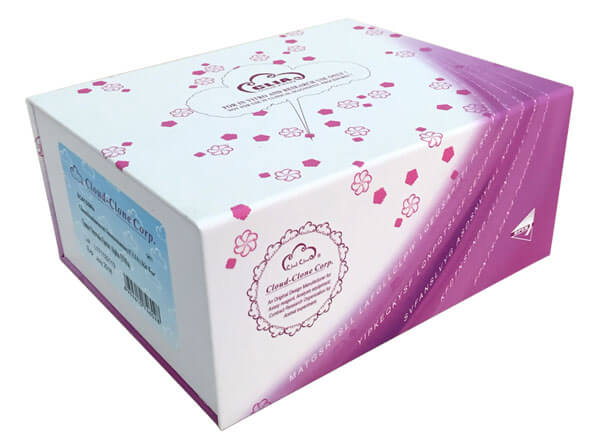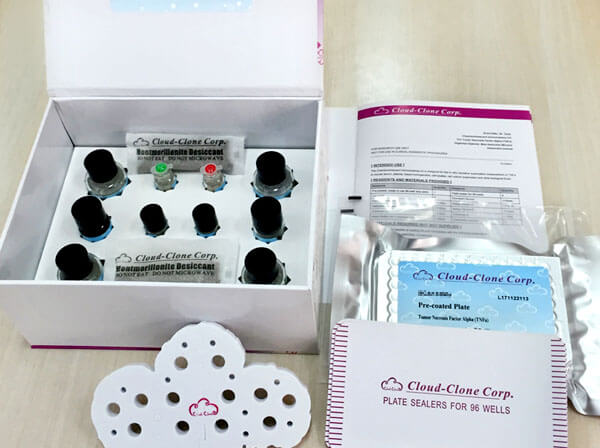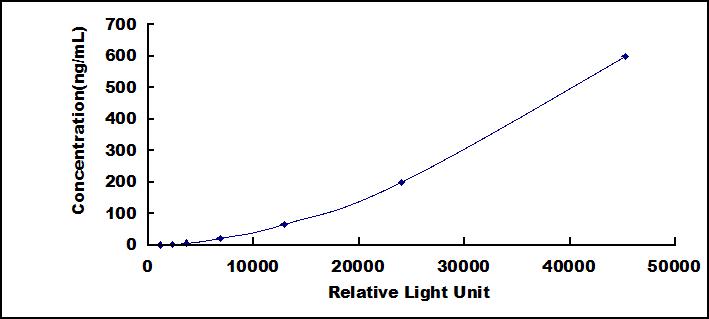CLIA Kit for Insulin Like Growth Factor Binding Protein 7 (IGFBP7) 

FSTL2; IGFBP-7v; MAC25; PSF; TAF; IGFBP-rP1; MAC25 protein; Prostacyclin-stimulating factor; PGI2-stimulating factor; Tumor-derived adhesion factor
- UOM
- FOB US$ 588.00 US$ 840.00 US$ 3,780.00 US$ 7,140.00 US$ 58,800.00
- Quantity
Overview
Properties
- Product No.SCB673Hu
- Organism SpeciesHomo sapiens (Human) Same name, Different species.
- ApplicationsChemiluminescent immunoassay for Antigen Detection.
Research use only - DownloadInstruction Manual
- CategoryMetabolic pathway
Sign into your account
Share a new citation as an author
Upload your experimental result
Review

Contact us
Please fill in the blank.
Recovery
Matrices listed below were spiked with certain level of recombinant Insulin Like Growth Factor Binding Protein 7 (IGFBP7) and the recovery rates were calculated by comparing the measured value to the expected amount of Insulin Like Growth Factor Binding Protein 7 (IGFBP7) in samples.
| Matrix | Recovery range (%) | Average(%) |
| serum(n=5) | 79-94 | 88 |
| EDTA plasma(n=5) | 86-93 | 90 |
| heparin plasma(n=5) | 78-90 | 85 |
Precision
Intra-assay Precision (Precision within an assay): 3 samples with low, middle and high level Insulin Like Growth Factor Binding Protein 7 (IGFBP7) were tested 20 times on one plate, respectively.
Inter-assay Precision (Precision between assays): 3 samples with low, middle and high level Insulin Like Growth Factor Binding Protein 7 (IGFBP7) were tested on 3 different plates, 8 replicates in each plate.
CV(%) = SD/meanX100
Intra-Assay: CV<10%
Inter-Assay: CV<12%
Linearity
The linearity of the kit was assayed by testing samples spiked with appropriate concentration of Insulin Like Growth Factor Binding Protein 7 (IGFBP7) and their serial dilutions. The results were demonstrated by the percentage of calculated concentration to the expected.
| Sample | 1:2 | 1:4 | 1:8 | 1:16 |
| serum(n=5) | 95-102% | 87-101% | 93-101% | 94-105% |
| EDTA plasma(n=5) | 84-101% | 82-99% | 83-101% | 80-89% |
| heparin plasma(n=5) | 89-104% | 84-98% | 82-96% | 96-104% |
Stability
The stability of kit is determined by the loss rate of activity. The loss rate of this kit is less than 5% within the expiration date under appropriate storage condition.
To minimize extra influence on the performance, operation procedures and lab conditions, especially room temperature, air humidity, incubator temperature should be strictly controlled. It is also strongly suggested that the whole assay is performed by the same operator from the beginning to the end.
Reagents and materials provided
| Reagents | Quantity | Reagents | Quantity |
| Pre-coated, ready to use 96-well strip plate | 1 | Plate sealer for 96 wells | 4 |
| Standard | 2 | Standard Diluent | 1×20mL |
| Detection Reagent A | 1×120µL | Assay Diluent A | 1×12mL |
| Detection Reagent B | 1×120µL | Assay Diluent B | 1×12mL |
| Substrate A | 1×10mL | Substrate B | 1×2mL |
| Wash Buffer (30 × concentrate) | 1×20mL | Instruction manual | 1 |
Assay procedure summary
1. Prepare all reagents, samples and standards;
2. Add 100µL standard or sample to each well. Incubate 1 hours at 37°C;
3. Aspirate and add 100µL prepared Detection Reagent A. Incubate 1 hour at 37°C;
4. Aspirate and wash 3 times;
5. Add 100µL prepared Detection Reagent B. Incubate 30 minutes at 37°C;
6. Aspirate and wash 5 times;
7. Add 100µL Substrate Solution. Incubate 10 minutes at 37°C;
8. Read RLU value immediately.

Test principle
The microplate provided in this kit has been pre-coated with an antibody specific to Insulin Like Growth Factor Binding Protein 7 (IGFBP7). Standards or samples are then added to the appropriate microplate wells with a biotin-conjugated antibody specific to Insulin Like Growth Factor Binding Protein 7 (IGFBP7). Next, Avidin conjugated to Horseradish Peroxidase (HRP) is added to each microplate well and incubated. Then the mixture of substrate A and B is added to generate glow light emission kinetics. Upon plate development, the intensity of the emitted light is proportional to the Insulin Like Growth Factor Binding Protein 7 (IGFBP7) level in the sample or standard.;
Giveaways
Increment services
-
 Single-component Reagents of Assay Kit
Single-component Reagents of Assay Kit
-
 Lysis Buffer Specific for ELISA / CLIA
Lysis Buffer Specific for ELISA / CLIA
-
 Quality Control of Kit
Quality Control of Kit
-
 CLIA Kit Customized Service
CLIA Kit Customized Service
-
 Disease Model Customized Service
Disease Model Customized Service
-
 Serums Customized Service
Serums Customized Service
-
 TGFB1 Activation Reagent
TGFB1 Activation Reagent
-
 Real Time PCR Experimental Service
Real Time PCR Experimental Service
-
 Streptavidin
Streptavidin
-
 Fast blue Protein Stain solution
Fast blue Protein Stain solution
-
 Single-component Reagents of FLIA Kit
Single-component Reagents of FLIA Kit
-
 Streptavidin-Agarose Beads
Streptavidin-Agarose Beads
Citations
- Role of IGFBP7 in Diabetic Nephropathy: TGF-β1 Induces IGFBP7 via Smad2/4 in Human Renal Proximal Tubular Epithelial CellsPubmed:26974954
- Role of IGFBP7 in Diabetic Nephropathy: TGF-β1 Induces IGFBP7 via Smad2/4 in Human Renal Proximal Tubular Epithelial Cells.pubmed:26974954
- Urine-Based Biomarkers for Alzheimer's Disease Identified Through Coupling Computational and Experimental MethodsPubmed:30040720
- IGFBP7 Drives Resistance to Epidermal Growth Factor Receptor Tyrosine Kinase Inhibition in Lung CancerPubmed: 30609749
- Insulin-like growth factor-binding protein 7 (IGFBP 7) as a new biomarker in coronary heart diseasePubmed: 30769262
- Altered insulin-like growth factor-2 signaling is associated with psychopathology and cognitive deficits in patients with schizophreniaPubmed: 32191705
- Discovery of novel biomarkers for atherosclerotic aortic aneurysm through proteomics-based assessment of disease progressionPubmed: 32286426
- SNORD116 and growth hormone therapy impact IGFBP7 in Prader¨CWilli syndrome34040195
- Biomarkers of persistent renal vulnerability after acute kidney injury recovery34707157
- IGFBP7 Concentration May Reflect Subclinical Myocardial Damage and Kidney Function in Patients with Stable Ischemic Heart DiseasePubmed:35204773
- Insulin-Like Growth Factor-Binding Protein 7 (IGFBP-7)—New Diagnostic and Prognostic Marker in Symptomatic Peripheral Arterial Disease?—Pilot StudyPubmed:35625639








